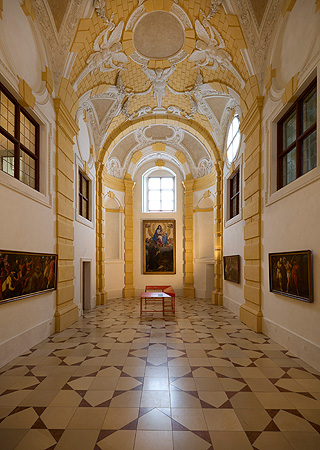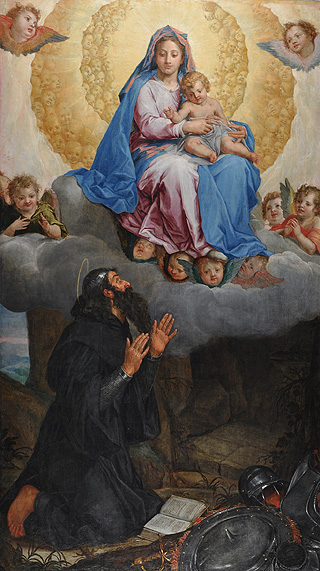Main information:

Schleißheim Old Palace
St William’s Chapel (Wilhelmskapelle)
The Schleissheim palace complex was founded by Duke Wilhelm V of Bavaria (r. 1579-1597), who built a simple manor house in this location in 1598. This was replaced not very long afterwards by his son Maximilian I (r. 1597-1651) with a much grander new building. Like his father’s mansion, this also had its own chapel.
In the Second World War the Old Palace was badly damaged in two air raids. St William’s Chapel was however preserved largely intact. Much of the stucco-work still decorating the vault dates back to the early 17th century.
The chapel was deconsecrated as early as 1818 and divided by a second ceiling into two rooms that served as a festival hall and stables. Reconstruction of the palace was only begun in 1970, in the process of which the second ceiling was removed.

The works of art in St William’s Chapel
Altar painting: St William’s vision of the Virgin Mary
Peter Candid, c. 1600, oil on canvas
The altar painting by Peter Candid (c. 1548-1628) had already been produced in around 1600 for the chapel of the preceding building; it shows the French saint as a hermit, barefoot and with long hair and beard. He gazes with wonder into the upper part of the painting, which is taken up with a vision of Mary with the Child and angels. The picture is not so much an actual legend about the saint as a call to engage in silent prayer.
Today the chapel is also decorated with four pictures (Christ before Caiaphas, Carrying the Cross, Flagellation of Christ, Christ Nailed to the Cross) from a thirteen-part Passion cycle by an unknown atelier. The paintings reflect the style of Peter Candid, which was very popular at the time. They were originally in the church belonging to Munich’s Franciscan monastery; both monastery and church were pulled down in 1802 following secularization. The pictures formerly decorated the rood screen, a partition that separated the section of the chapel reserved for the monks from that of the laity. The rest of the depictions are now kept in the depot of Schleissheim New Palace.

Facebook Instagram YouTube